Higher Education in Financial Management Technology: a comparative study between classroom and distance learning
By Daniel Christian Henrique
Jucemar Paes Neto
Luiz Ricardo Mendes da Silva
Eduardo de Souza Ronsoni
The dissemination of higher technology courses in the last decade lasting 2 to 3 years with a greater focus on market practices has made it possible to achieve the longed-for higher education diploma accompanied by an immersion in more specific situations of problems in the labor market. In view of this teaching niche, pedagogical practices and resources often need to be differentiated, not allowing the maintenance of the transmission of teacher-student content only through expository classes. Teaching with the use of digital materials, audiovisual resources, in computer labs or with accessibility to students with visual or hearing impairment, partial or total, are some of the examples that could become a differential in the search of students for this course profile, as well as the incentive to complete them.
In sum, the emergence in 2020 of the coronavirus pandemic has made this reality even more explicit, with all students and teachers from public and private schools and universities being forced to adapt face-to-face teaching to distance learning routines in a matter of months. Many experiences stand out as positive and many, in turn, as negative. It is enough to note the current great discussion of states and municipalities for the resumption in the next months of face-to-face education, taking the necessary hygiene and health measures to prevent the spread of the virus. Therefore, it is essential to discuss what has already been positively adding both to face-to-face and distance learning in this very specific niche of education, which are the higher technology courses, for an even better adaptation today as for the next year for both modalities.
The pedagogical problems become even more accentuated for the Higher Technology Course in Financial Management, which in turn, has even more specific characteristics due to the fact that it engages a considerable part of its curriculum in mathematical applications of financial calculations together with the use of practical tools. accessible in spreadsheets and financial calculators. Any discipline with a greater focus on the exact area goes through the need and challenge of leveling in the same class the different basic mathematics knowledge obtained by students in high school, found that they often enter higher education with low levels of knowledge in this area. In face-to-face subjects, teacher supervision in the classroom with support from tutoring at alternative times has become a common practice, supported by later studies of printed materials by students. However, are modern teaching technologies with audiovisual, accessibility or even laboratory resources making a difference in the face-to-face financial management course? The discussion is even more pertinent when approaching its distance modality, in which the greater physical distance of the student with the teacher and tutor requires even more of varied means and teaching tools to solve the doubts in the calculations made by the students. Despite the use of classroom hubs by some educational institutions, it is not always possible for a good portion of students to attend them with some regularity, making learning through virtual means of interaction and teaching their main source of information.
Within this context, the questions arise: (1) which teaching resources available in the variables of INEP (2020) in its Higher Education Census would be more contributing to the entry and conclusion of students in higher education technology courses in financial management in the face-to-face and the distance? The explanatory variables that could then be attributed to this first question were: digital material, printed material, audio material, communication resources, computer resources, use of laboratory, offer of semi-classroom discipline (for face-to-face modality), expanded material, tactile material, braille material, material in Libras (Linguagem Brasileira de Sinais, “Brazilian sign language”), Libras subject, translator of Libras and support of interpreters.
In step, sought to understand (2) which of these same variables would still be impacting the use of accessibility resources, such as the use of materials in Libras, materials in Braille and accessible digital resources, but now allocating the latter as explanatory variables (in isolation) and the number of freshmen and seniors as explanatory variables. Subsequently, the use of computer resources and the use of semi-face-to-face subjects (only for the face-to-face course) was also used as a dependent variable, also with the aim of understanding which of the offering variables would best explain their adequation for this type of course.
Methodology
To meet the research objectives, the following variables were collected in the MEC Higher Education Census for 2018, the year with the last update of the ministry, the following variables (INEP, 2020) for the 223 face-to-face courses and 98 distance courses of Financial Management (also considering the nomenclature Corporate Finance Management) operating in Brazil. Inactive courses or courses that have not yet graduated students have been dropped from the final list:
- QT_CONCLUINTE_TOTAL: number of graduates of the course with a graduate status. Discrete variable.
- QT_INGRESSO_TOTAL: number of entrants in the course from January 1st to July 1st. Discrete variable.
- NU_CARGA_HORARIA: minimum course load. Discrete variable.
- QT_VAGA_TOTAL: total number of places offered by the course. Discrete variable.
- QT_MATRICULA_TOTAL: number of enrollments in the course, adding students with ongoing course and graduate status. Discrete variable.
- IN_MATERIAL_DIGITAL: use of accessible digital material. Binary variable: (0) No (course has other means of accessibility) and (1) Yes.
- IN_MATERIAL_AMPLIADO: use of material in printed format in enlarged character. Binary variable: (0) No (course has other means of accessibility) and (1) Yes.
- IN_MATERIAL_TATIL: use of material in tactile format. Binary variable: (0) No (course has other means of accessibility) and (1) Yes.
- IN_MATERIAL_IMPRESSO: use of accessible printed material. Binary variable: (0) No (course has other means of accessibility) and (1) Yes.
- IN_MATERIAL_AUDIO: use of audio material. Binary variable: (0) No (course has other means of accessibility) and (1) Yes.
- IN_MATERIAL_BRAILLE: use of Braille material. Binary variable: (0) No (course has other means of accessibility) and (1) Yes.
- IN_MATERIAL_LIBRAS: use of didactic material in Brazilian sign language. Binary variable: (0) No (course has other means of accessibility) and (1) Yes.
- IN_DISCIPLINA_LIBRAS: course offers discipline of Brazilian sign language. Binary variable: (0) No (course has other means of accessibility) and (1) Yes.
- IN_TRADUTOR_LIBRAS: course offers translator and interpreter of Brazilian sign language. Binary variable: (0) No (course has other means of accessibility) and (1) Yes.
- IN_GUIA_INTERPRETE: course offer guide-interpreter. Binary variable: (0) No (course has other means of accessibility) and (1) Yes.
- IN_RECURSOS_COMUNICACAO: use of communication accessibility features. Binary variable: (0) No (course has other means of accessibility) and (1) Yes.
- IN_RECURSOS_INFORMATICA: use of accessible computer resources. Binary variable: (0) No (course has other means of accessibility) and (1) Yes.
- IN_OFERECE_DISC_SEMI_PRES: informs if the classroom course uses semi-classroom discipline. Binary variable: (0) No and (1) Yes.
- IN_POSSUI_LABORATORIO: informs if the course uses laboratory. Binary variable: (0) No and (1) Yes.
- IN_INTEGRAL: discusses whether the classroom course is a full-time shift or not. Binary variable: (0) No and (1) Yes.
- IN_MATUTINO: discusses whether the classroom course is in the morning or not. Binary variable: (0) No and (1) Yes.
- IN_VESPERTINO: discusses whether the classroom course is in the afternoon or not. Binary variable: (0) No and (1) Yes.
- IN_NOTURNO: discusses whether the classroom course is a night shift or not. Binary variable: (0) No and (1) Yes.
- IN_CAPITAL: informs if the classroom course is located in the state capital or not. Binary variable: (0) No and (1) Yes.
- IN_GRATUITO: discusses whether the course is free or not. Binary variable: (0) No and (1) Yes.
Because there are binary and discrete variables, logistic and multiple regression procedures were configured, respectively, for each type reported. However, most are denoted as binary, with a greater number of logistic regressions under analysis.
For both situations, regressions were performed with stepwise backward procedures, with subsequent statistical analyzes of approval of the equation coefficients by methodologies relevant to each type of analysis, as well as the general equation.
SUPERIOR TECHNOLOGY COURSE IN FINANCIAL MANAGEMENT - DISTANCE MODE
Number of newcomers and graduates
For the technologist course of Financial Management in distance learning, among the 25 variables under analysis, those that were strictly related to the face-to-face course were not computed, namely: IN_OFERECE_DISC_SEMI_PRES, IN_INTEGRAL, IN_MATUTINO, IN_VESPERTINO, IN_NOTURNO, IN_CAPITAL. Thus, the remaining 19 variables were considered for the initial formulation of each predictive equation for the distance course. As noted in sequence, the number of new entrants to this course modality was strictly linked to the variables of number of total vacancies, total enrollments and total graduates. The equation points to normality of the residuals in its boxplot graph.

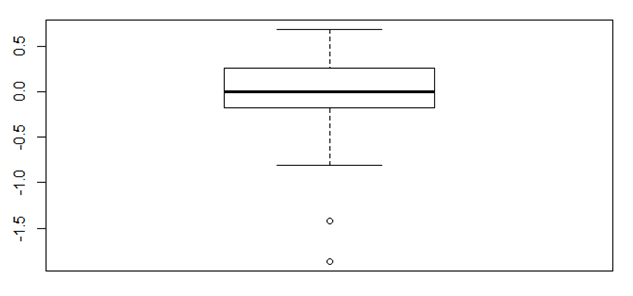
It is concluded that the vacancies offered are an attractive and that the enrollments made, in turn, are reflected in the number of entrants. In addition, the number of graduates seems to be stimulating the entry of new students, offering an indication of the non-occurrence of strong evasion of technologists in financial management.
As for the numbers of graduates, the following relationship can be developed based on the predictive equation and normalized residues, against a 0.09 result in the Shapiro-Francia test:

The prevalence of the number of enrollments and newcomers in the prediction of the number of graduates makes it possible to infer an adequate proportionality between the variables, confirming the previous finding that there are indications of non-occurrence of mass dropouts from this type of technological course. The biggest difference is the statistical significance of accessible digital materials as essential for completing the course, without any approval of the variables of printed, expanded, audio, Braille or Libras. However, this does not detract from the importance of the latter, but what stands out is the relevance that students offer to the use of digital material in the Financial Management Distance Learning course. In this way, this variable will be analyzed in sequence, but now taken as a dependent.
Accessible Digital Material
As it is a binary variable (1- has digital material, 0- does not have digital material), a logistic regression was performed, using the stepwise method with a 5% significance level. The remaining outputs among the 19 variables under analysis are shown in the table below.
MCfadden’s R2 | ML (Cox-Snell) R2 | Nagelkerke R2 | AUROC |
0.507 | 0.410 | 0.634 | 0.9249 |
Variáveis | Estimate | Z value | Pr(<|Z|) |
(Intercept) | -2.3968 | -3.143 | 0.001671 |
IN_MATERIAL IMPRESSO | 1.6278 | 2.067 | 0.038724 |
IN_MATERIAL AUDIO | 2.8515 | 3.675 | 0.000238 |
IN_RECURSOS_COMUNICAÇÃO | 2.2679 | 2.866 | 0.004163 |
It is possible to observe the good predictive capacity of the model, evidenced by the MCfadden’s and Cragg-Uhler tests that obtained an R squared of 0.507 and 0.634 respectively, as well as by its AUROC value of 0.9249.
Among the variables that presented the greatest possibility of prediction, it is interesting to observe the appearance of the use of printed material. As previously reported, the absence of some variables in explaining the number of students completed does not eliminate the relevance of the importance of one or the other variable when analyzing its impact on other variables that have been shown to be essential to the entry or graduation of students. The digital materials accessible to the disabled, as seen, are essential for students to reach the end of their academic journeys, but it can be inferred now that without the parallel use of printed materials, the explanatory degree of the first variable might not be so significant.
The relevance of the accessible digital material obtained still came to require the use of accessible audio materials and other communication resources, both with relatively equal coefficient values. These variables are perfectly integrated in the execution of learning for a distance course modality. However, it is important to note that the INEP variable dictionary (2020) highlights audio materials as essentially audio to help students with disabilities, denoting that digital materials are integrated with the inclusion needs of students. In view of the relevance of this finding, it is important to study in sequence the possible explanations that impact accessibility materials for Libras and Braille.
Materials in Libras and Braille
Following the same line of reasoning as before, what could contribute to a distance Financial Management course using or not using material in Libras? In order to answer this question, another logistic regression was performed, since it is again a binary variable. Below you can see the outputs, setting up a good forecasting power again.
MCfadden’s R2 | ML (Cox-Snell) R2 | Cragg-Uhler(Nagelkerke) R2 | AUROC |
0.411 | 0.433 | 0.578 | 0.8891 |
Variáveis | Estimate | Z value | Pr(<|Z|) |
(Intercept) | -11.120921 | -2.867 | 0.004145 |
NU_CARGA_HORARIA | 0.005421 | 2.491 | 0.012729 |
IN_MATERIAL_TATIL | 2.680344 | 3.740 | 0.000184 |
IN_MATERIAL_BRAILE | 1.743546 | 2.603 | 0.009232 |
QT_CONCLUINTE_TOTAL | 0.005989 | 2.110 | 0.034840 |
The total course load in conjunction with the use of tactile and braille materials was significant for the use of materials in Libras. Thus, an adequate study between the course load and the load using Libras is preponderant for the good performance of the community with hearing deficiency or deafness. The dependency relationship still obtained between the resources for different types of disabilities, hearing and vision, may indicate a joint and equal action by the coordination of these courses between pedagogical materials for these two accessibility needs of the students, not prioritizing one or the other. In this specific case, there is a possibility of a spurious relationship between the variables, in which there is no evident cause and effect relationship between them. After taking the Braille Material variable as a dependent, this information can be confirmed or refuted:
MCfadden’s R2 | ML (Cox-Snell) R2 | Cragg-Uhler(Nagelkerke) R2 | AUROC |
0.478 | 0.457 | 0.633 | 0.9175 |
Variáveis | Estimate | Z value | Pr(<|Z|) |
(Intercept) | -5.8138 | -3.8479 | 1e-04 |
IN_MATERIAL_AMPLIADO | 1.9056 | 2.1527 | 0.0313 |
IN_MATERIAL_TATIL | 1.9451 | 2.8460 | 0.0044 |
IN_MATERIAL_LIBRAS | 1.4164 | 2.0883 | 0.0368 |
IN_TRADUTOR_LIBRAS | 2.5021 | 1.9963 | 0.0459 |
The previous finding is confirmed, since now there has only been an exchange of positions between the variables, with the material in Libras together with the translator of Libras now taking the place of explanations. In addition to the predictive variables, the use of enlarged material and tactile material - both in this case with total synergy with Braille materials. No other variable was found to be relevant.
Accessible Computer Resources
Taking into account the importance of using spreadsheet tools and financial calculators in the development of calculations in the financial management course, a final analysis of the relevance of the impacting variables regarding the approach to IT resources is necessary.

The coefficients found for the equation were supported by the Nagelkerke statistic equal to 0.516, McFadden equal to 0.412 and AUROC 0.9004. The communication resources came to compose strong approval and a high positive coefficient to predict the use of computer resources. In its explanation the use of audio materials was followed, reinforcing once again the importance of accessibility materials in the routine of developing teaching and learning of the distance course.
SUPERIOR TECHNOLOGY COURSE IN FINANCIAL MANAGEMENT - PRESENTIAL MODE
Number of Entrants
The response variable was allocated to “Total entrant quantity” and all others as independent. Multiple regression was performed using the stepwise backward method. For the face-to-face course modality, all 25 variables are addressed. After running the regression procedures, only 7 of them were significant to the equation because they did not show multicollinearity between themselves, reaching an adjusted R square of 86.58% and an F test with a value of 0.0000, permeating an excellent representativeness value. The regression residues showed positioning of white noise, however with slight formations - explaining the absence of any variable not posted in the model, but which was still considered adequate for the use of the developed equation, as seen below:
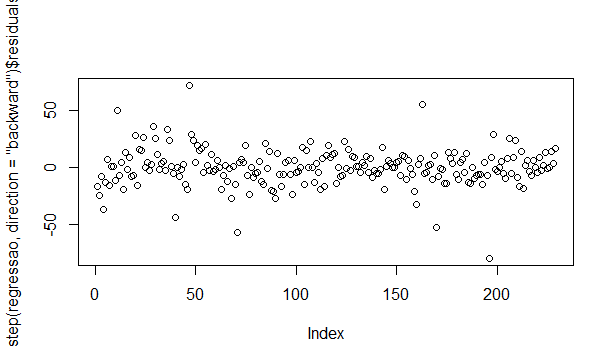
The coefficients of the equation and their probability values for the null hypothesis are:
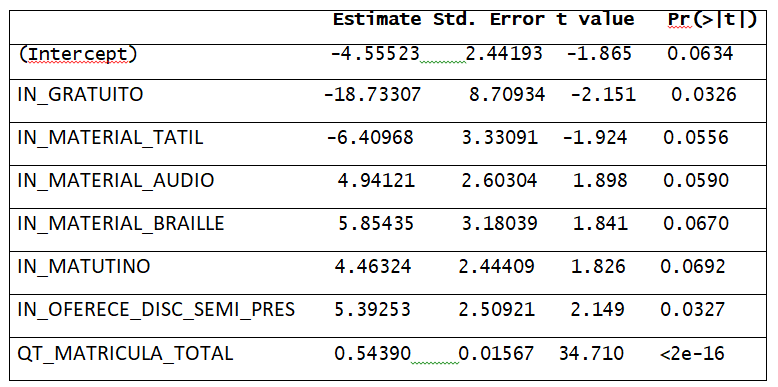
Therefore, the seven variables above proved to be significant in explaining student enrollment. The number of total enrollments is in line with the number of entrants in the first semester, as expected, but with a coefficient value below 1.0. The other two variables contributed coefficients with much more extreme values. It should be noted that the fact that the course in financial management is in the morning has attracted much more students' attention than full or evening courses. Ditto for the presence of semi-presential subjects, which allows their development outside the university at alternative times and better adjusted to the schedule of each student. The gratuity of courses offered by public universities cannot be the motivation of the morning course to obtain greater prominence in the admission, since this first one has a negative coefficient and is highly representative. The fact that free courses are largely full-time, may be the understanding of this negative relationship, which would not allow students to work in another period. Because this course is aimed at professionals already working in the market, it is noticeable that the search for this course has better support in the possibility of working in any of the periods, morning or afternoon. Another proof of this understanding is the fact that the presence of semi-face-to-face subjects adds significance, as it generates flexible schedules for students on one or a few days of the week. It is understood from these findings, finally, that the profile of the students of this course opts mainly for courses from private universities.
In terms of accessibility, there was strong approval for the need for Braille material. Interestingly, the presence of tactile material had a negative coefficient, indicating an inverse relationship to the stimulus to enter the finance course. The fact that the numerous tactile materials available in the education market, added to the need for a matrix of quantitative subjects in the course, could discourage the entry of this student profile? Those with accessibility needs, in turn, seek the diploma of finance technologist with materials in Braille, as confirmed in the data, as well as audio materials. It is noted that accessibility to partial or total visual impairments were the pedagogical factors of greatest search.
Number of Graduates
As it is a discrete variable, again, a multiple regression was applied with the variable Total Graduates as the response variable and the others as independent. The Stepwise Backward procedure was performed and elimination of the Outliers values of the dependent variable. The result of this removal can be seen in the Boxplot below comparing before and after removal:

The results are shown in the equation model below:
Coeficiente | Valor Estimado | Erro Padrão | Valor-Z | Valor-P |
(Intercept) | -22.65809 | 2.77231 | -8.173 | 1.36e-13 |
IN_TRADUTOR_LIBRAS | 1.19005 | 0.47429 | 2.509 | 0.0132 |
IN_NOTURNO | 22.62244 | 2.69686 | 8.388 | 3.99e-14 |
QT_INGRESSO_TOTAL | -0.34353 | 0.01917 | -17.923 | < 2e-16 |
QT_MATRICULA_TOTAL | 0.47596 | 0.01383 | 34.425 | < 2e-16 |
The equation had an adjusted R² of 0.9447, passing the F test with a P-value less than 2.2 E-16. The normality of the residues was significant, as can be seen in the Boxplot and in the Kolmogorov-Smirnov test result equivalent to 0.0789:
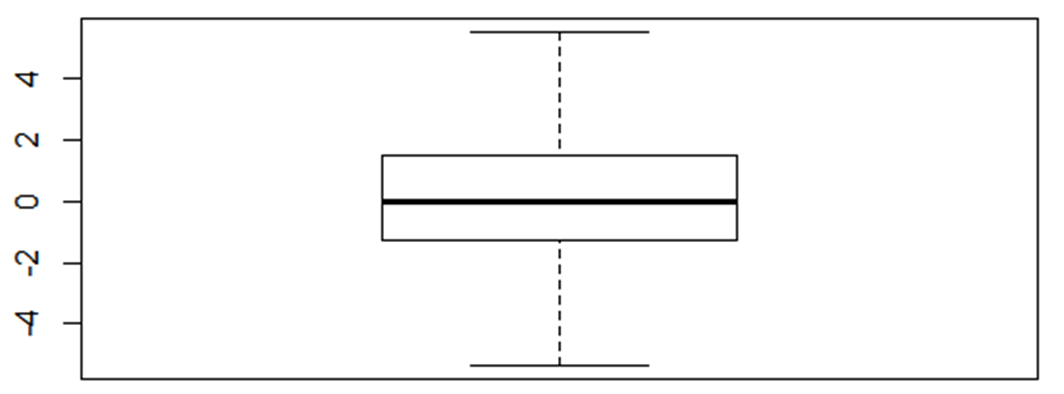
Interestingly, the situation of the graduates was inverted with respect to the expectations of the freshmen. Now, the variable that most strongly impacted the number of graduates was the fact that the course is evening (with a high coefficient of 22.62). The previous results showed that admission to this course was a priority due to the fact that it was presented in the morning format, but the subsequent two to three years of course provided those who were enrolled in evening courses with greater possibilities of graduation. The fact that the amount of admission brings a negative coefficient, demonstrates that the more students who enter, the number of graduates is reduced. This demonstrates the degree of evasion of the course proportional to its coefficient. The amount of enrollment to be significant was again expected due to its close relationship with this variable: to complete the course, it is necessary to be in a situation of connection with the institution or in a graduate situation.
Among the variables most related to the pedagogical part, only the need for the presence of Libras translators was highlighted. This was another major change. Materials for partially or totally blind people were more stimulating to enter the course (Braille and audio), but materials in Libras for the hearing impaired were the ones that most increased the number of graduates. This research finding can serve as a stimulus for technology courses in financial management to improve teaching related to the visually impaired, especially regarding the necessary calculations in the disciplines.
Semi-presential discipline offering
Taking into account the relevance that the offer of semi-presence discipline brought in the students' entrance, it was tried to understand if this variable was influenced by the other variables now under analysis, taking it at this moment with the dependent variable. Because it is binary, logistic regression procedures were applied, incurring the following results:
MCfadden’s R2 | ML (Cox-Snell) R2 | Cragg-Uhler(Nagelkerke) R2 | AUROC |
0.189 | 0.199 | 0.288 | 0.7839 |
Coeficiente | Valor Estimado | Valor-Z | Valor-P |
(Intercept) | 3,426644 | 2,045000 | 0,040890 |
NU_CARGA_HORARIA | -0,002901 | -3,106000 | 0,001895 |
IN_DISCIPLINA_LIBRAS | 1,752629 | 3,263000 | 0,001101 |
IN_TRADUTOR_LIBRAS | 0,988576 | 2,666000 | 0,007672 |
QT_CONCLUINTE_TOTAL | -0,037537 | -2,832000 | 0,004624 |
QT_INGRESSO_TOTAL | 0,030826 | 3,584000 | 0,000339 |
Even with all the approved coefficients, the model presented low values in the pseudo-R² and in the other statistics of logistic regression models. It should be noted, however, that its AUROC result was more expressive, reaching 0.7839.
The number of new entrants confirmed its relevance for this variable, indicating that the greater the students' search for technologist courses in finance, the likelihood of this course having semi-presential courses increases. However, the graduates denote another reality. The greater the number of graduates, the likelihood that the course has semi-presential discipline decreases, given the presence of a negative, but low coefficient, this decrease is not so significant. The adoption of semi-presential discipline in Libras with a translator became the most relevant variable as they have the highest coefficients.
Accessible Digital Materials
Because the presence of accessible digital materials was relevant in the forecast equation of the graduates of the distance-learning course, it was also sought to ascertain for comparison which variables would be the most influential for these courses to also adopt these digital in the face-to-face modality:
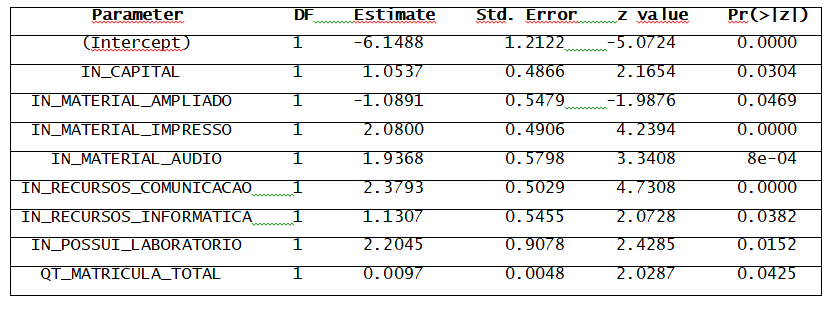
Estatísticas do Modelo | |
MCFadden's R2 | 0.556 |
McFadden's Adj R2 | 0.497 |
ML (Cox-Snell) R2 | 0.523 |
Cragg-Uhler (Nagelkerke) R2: | 0.710 |
Concordância | 0.942 |
Discordância | 0.058 |
Essentially, face-to-face financial management courses that address digital materials are most effective in their use when they are located in state capitals, have laboratories and adopt computer and communication resources. In addition, they address printed materials together with digital material and integrate with enlarged and audio materials to support accessibility.
Materials in Libras and Braille
The adoption of accessibility materials in Libras of the face-to-face course followed the same pattern of explanatory variables of the distance course, offering synergy to the use of tactile and braille materials (with possible spurious relationship between the variables) but there was a difference in the presence of significance statistics for interpreter guides, as well as for addressing audio accessibility materials and communication resources. The relevance of the use of audio material is not contradictory in view of the different levels of disability that affect hearing and that require materials compatible with hearing aids, as well as applicable to communication resources with visual alternatives to sound, that is, with a subtitle approach , visual alerts, among many other features.
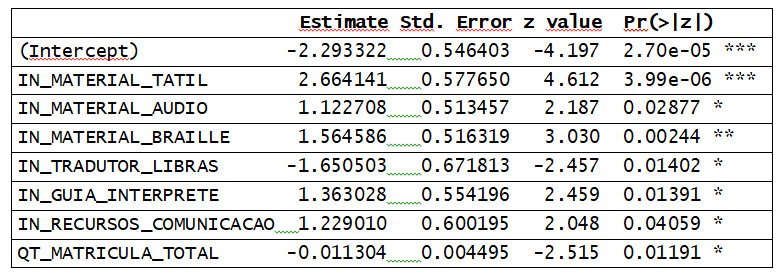
Estatísticas do Modelo | |
MCFadden's R2 | 0.524 |
McFadden's Adj R2 | 0.468 |
ML (Cox-Snell) R2 | 0.481 |
Cragg-Uhler (Nagelkerke) R2: | 0.673 |
Concordância | 0.928 |
Discordância | 0.072 |
With regard to materials in Braille, the biggest difference in relation to distance learning was the relevance of courses in the capital to provide a negative explanation in the adoption of this accessibility to students. The other relations are equivalent:

Estatísticas do Modelo | |
AUROC | 0.914 |
MCFadden's R2 | 0.459 |
McFadden's Adj R2 | 0.610 |
ML (Cox-Snell) R2 | 0.433 |
Cragg-Uhler (Nagelkerke) R2: | 0.610 |
Concordance | 0.912 |
Discordance | 0.088 |
Accessible Computer Resources
As a final treatment, analyzes were set up to record the possible explanations for the importance of computer resources accessible in the face-to-face course, obtaining the following equation, justified by the Nagelkerke (0.599) and McFadden's (0.464) tests, confirmed by the concordance statistic of 0.904:
Coeficiente | Estimate | Std. Error | z value | Pr(>|z|) |
(Intercept) | 1.3383 | 0.6453 | 2.074 | 0.038076 |
IN_MATERIAL_DIGITAL | 2.0122 | 0.5417 | 3.715 | 0.000203 |
IN_MATERIAL_AMPLIADO | 1.7884 | 0.5501 | 3.251 | 0.001150 |
IN_MATERIAL_AUDIO | 2.2897 | 0.8567 | 2.673 | 0.007524 |
IN_MATERIAL_LIBRAS | -1.7102 | 0.7416 | -2.306 | 0.021095 |
IN_DISCIPLINA_LIBRAS | -2.7643 | 0.7285 | -3.794 | 0.000148 |
IN_RECURSOS_COMUNICACAO | 1.5903 | 0.5451 | 2.917 | 0.003529 |
There is a more significant number of approved variables, five of which are related to accessible materials. The highlight is the fact that the two variables of visual accessibility (enlarged material and audio) have positive coefficients, incurring in greater probability of the courses using computer resources when these materials are addressed. The variables of accessibility to hearing (material and discipline in Libras), the opposite, obtain a negative sign in their coefficients, indicating the greater amount of materials and disciplines in Libras decrease the probabilities of using computer resources. In addition, digital materials and communication resources have positively integrated the methodological approaches of the response variable.
References
INEP. Censo da Educação Superior. 2020. Available at: http://inep.gov.br/microdados. Accessed in: Aug. 17th 2020.